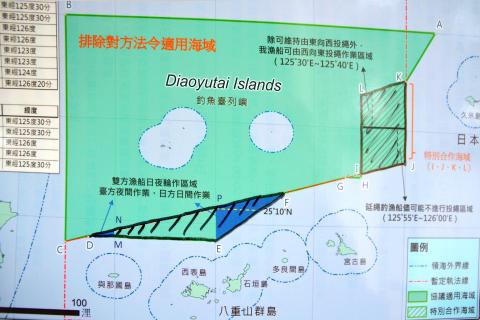The Ministry of Foreign Affairs (MOFA) yesterday pledged to safeguard Taiwanese fishermen’s interests at an upcoming meeting with Japan, amid demands by Japanese fishery associations that the boundaries set by a historic agreement between the two nations be narrowed.
“Regarding Okinawa fishery associations’ demands that Japanese authorities re-examine the areas in which the 2013 Taiwan-Japan fishery agreement are applicable, the Japanese government has yet to include the issue on the agenda of the fifth meeting of the Taiwan-Japan fishing commission from March 2 to March 4 in Taipei,” ministry spokesperson Eleanor Wang (王珮玲) said.
Wang said that if Japan brings up the issue during the meeting, Taiwan’s representatives would argue strongly for the nation’s interests and ask their Japanese counterparts to consider the achievements that have been made since the agreement’s signing.

Photo: Chu Tse-wei, Taipei Times
“At the moment, such demands are made only by local fishery groups in Japan and do not reflect the nation’s official stance,” Wang said, urging concerned parties to handle the matter in a rational manner.
Wang made the remarks one day after representatives of the Yilan-based Suao Fishermen’s Association and other fishery groups urged the government to stand up for their rights during the meeting, or they would mobilize fishermen to surround the disputed Diaoyutai Islands (釣魚台) as a form of protest.
The Taiwan-Japan fishing commission was established after the two nations in April 2013 signed a pact on fishing rights in the East China Sea near the Diaoyutais, which Japan calls the Senkaku Islands.
Under the terms of the agreement, Taiwanese and Japanese boats can operate freely in a 74,300km2 area around the archipelago.
An amendment to the pact was passed last year, allowing Taiwanese and Japanese fishing boats to take turns operating in the area north of the Yaeyama Islands and maintain a 4 nautical mile (7.4km) distance between each boat while fishing.
Wang said the agreement has established an institutionalized negotiation mechanism between Taipei and Tokyo, allowing both sides to jointly explore fishery resources and their fishermen to operate in peace.
“It is a concrete embodiment of [President Ma Ying-jeou’s (馬英九)] East China Sea peace initiative and has set a successful precedent for peaceful resolution of conflicts,” Wang said.

CROSS-STRAIT COLLABORATION: The new KMT chairwoman expressed interest in meeting the Chinese president from the start, but she’ll have to pay to get in Beijing allegedly agreed to let Chinese Nationalist Party (KMT) Chairwoman Cheng Li-wun (鄭麗文) meet with Chinese President Xi Jinping (習近平) around the Lunar New Year holiday next year on three conditions, including that the KMT block Taiwan’s arms purchases, a source said yesterday. Cheng has expressed interest in meeting Xi since she won the KMT’s chairmanship election in October. A source, speaking on condition of anonymity, said a consensus on a meeting was allegedly reached after two KMT vice chairmen visited China’s Taiwan Affairs Office Director Song Tao (宋濤) in China last month. Beijing allegedly gave the KMT three conditions it had to

STAYING ALERT: China this week deployed its largest maritime show of force to date in the region, prompting concern in Taipei and Tokyo, which Beijing has brushed off Deterring conflict over Taiwan is a priority, the White House said in its National Security Strategy published yesterday, which also called on Japan and South Korea to increase their defense spending to help protect the first island chain. Taiwan is strategically positioned between Northeast and Southeast Asia, and provides direct access to the second island chain, with one-third of global shipping passing through the South China Sea, the report said. Given the implications for the US economy, along with Taiwan’s dominance in semiconductors, “deterring a conflict over Taiwan, ideally by preserving military overmatch, is a priority,” it said. However, the strategy also reiterated

‘BALANCE OF POWER’: Hegseth said that the US did not want to ‘strangle’ China, but to ensure that none of Washington’s allies would be vulnerable to military aggression Washington has no intention of changing the “status quo” in the Taiwan Strait, US Secretary of Defense Pete Hegseth said on Saturday, adding that one of the US military’s main priorities is to deter China “through strength, not through confrontation.” Speaking at the annual Reagan National Defense Forum in Simi Valley, California, Hegseth outlined the US Department of Defense’s priorities under US President Donald Trump. “First, defending the US homeland and our hemisphere. Second, deterring China through strength, not confrontation. Third, increased burden sharing for us, allies and partners. And fourth, supercharging the US defense industrial base,” he said. US-China relations under

The Chien Feng IV (勁蜂, Mighty Hornet) loitering munition is on track to enter flight tests next month in connection with potential adoption by Taiwanese and US armed forces, a government source said yesterday. The kamikaze drone, which boasts a range of 1,000km, debuted at the Taipei Aerospace and Defense Technology Exhibition in September, the official said on condition of anonymity. The Chungshan Institute of Science and Technology and US-based Kratos Defense jointly developed the platform by leveraging the engine and airframe of the latter’s MQM-178 Firejet target drone, they said. The uncrewed aerial vehicle is designed to utilize an artificial intelligence computer